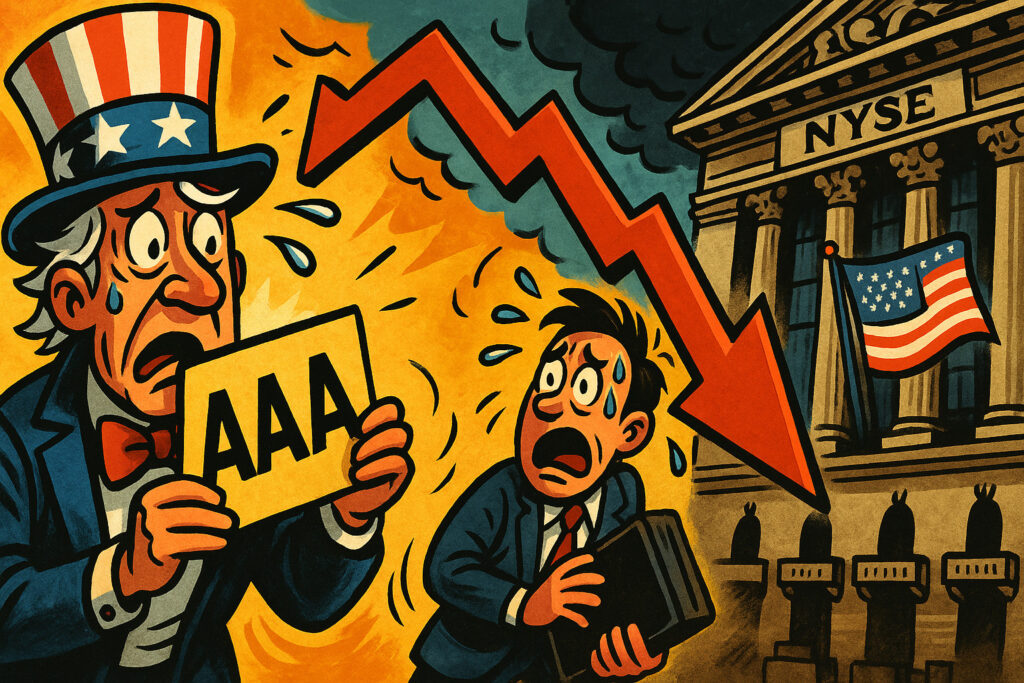Introduction
On May 19, 2025, Moody’s Investors Service downgraded the credit rating of the United States from Aaa to Aa1, citing growing fiscal imbalances, rising interest costs, and lack of a credible medium-term debt reduction plan. The move, while not unexpected, rattled financial markets already grappling with stretched valuations and fragile investor confidence.
Although the downgrade maintains the U.S. in the high-grade category, it marks only the second time in history that a major ratings agency has cut the U.S. sovereign rating. The last comparable event occurred in 2011 when S&P downgraded the U.S. to AA+.
Markets responded with a mix of volatility and caution. The S&P 500 fell 0.6% to 5,238, the Dow Jones Industrial Average lost 214 points (-0.56%) to close at 38,182, and the Nasdaq Composite declined 0.4% to 15,606.
Reasons Behind the Downgrade
Fiscal Deficits and Debt Burden
Moody’s cited several reasons for the downgrade:
- Federal debt-to-GDP ratio projected to exceed 120% by 2026
- Interest expense on the national debt surpassing $1 trillion annually
- Political gridlock limiting fiscal reforms and long-term deficit reduction
According to Moody’s:
“The U.S. government faces rising debt affordability challenges in the absence of broad fiscal consolidation measures.”
Political Dysfunction
The agency also flagged the inability of Congress to reach consensus on budgetary reforms and entitlement spending as a long-term credit risk. The recent near-shutdown and contentious debt ceiling negotiations further reinforced these concerns.
Market Reaction
Equity Market Selloff
Risk assets sold off modestly but orderly. Financials and cyclicals were the hardest hit:
- Bank of America (BAC): -2.2%
- JPMorgan Chase (JPM): -1.8%
- UnitedHealth Group (UNH): -1.5%
Technology held up better, with some investors rotating into growth stocks:
- Apple (AAPL): +0.3%
- Microsoft (MSFT): +0.2%
Fixed Income Turbulence
Treasury yields rose sharply as bond investors demanded higher compensation for perceived fiscal risk:
- 10-year yield: jumped 10 bps to 4.39%
- 30-year yield: +11 bps to 4.56%
Short-term yields rose slightly, but the curve steepened significantly. Municipal bonds and mortgage-backed securities also saw wider spreads.
Currency and Credit Markets
The U.S. dollar weakened against major peers:
- DXY: -0.5% to 102.9
- EUR/USD: rose to 1.092
- USD/JPY: dipped to 146.7
Credit default swaps (CDS) on U.S. sovereign debt widened by 8 bps to 45 bps, the highest level since 2020.
Safe Haven Flows
Investors rotated into traditional safe havens:
- Gold: +1.3% to $2,390/oz
- Swiss franc (CHF): appreciated by 0.4%
- Bitcoin: +1.8% to $101,340
The rise in crypto and precious metals underscored risk aversion and concern about the long-term value of fiat currencies.
Global Market Response
Overseas markets mirrored the cautious tone:
- FTSE 100: -0.6%
- DAX: -0.4%
- Nikkei 225: -0.5%
- Shanghai Composite: -0.7%
Asian central banks, including the Bank of Japan and People’s Bank of China, issued statements reaffirming confidence in U.S. debt markets but also hinted at portfolio diversification.
Policy and Political Response
The U.S. Treasury Department issued a sharp rebuttal, calling the downgrade “arbitrary and based on outdated metrics.” Treasury Secretary Janet Yellen emphasized:
“The U.S. remains the most creditworthy borrower in the world. Our debt is issued in the world’s reserve currency and enjoys unmatched liquidity.”
However, political reaction was divided:
- Republicans blamed excessive stimulus and entitlement spending
- Democrats cited tax cuts and fiscal gridlock
Both parties face growing pressure to address fiscal sustainability in upcoming budget negotiations.
Analyst Commentary
- Goldman Sachs: “While the downgrade is symbolically important, it does not materially change the creditworthiness of the U.S. in the short term.”
- BlackRock: “Expect some near-term volatility but limited long-term repricing unless further downgrades follow.”
- Citigroup: “Investors should monitor auction demand and foreign holdings of Treasuries for any sign of structural stress.”
Investor Strategy Implications
- Fixed Income: Consider shorter-duration bonds and inflation-protected securities (TIPS)
- Equities: Favor quality growth over cyclicals and leverage-light business models
- Alternatives: Hedge with gold, Swiss franc, or Bitcoin for long-term diversification
Conclusion
The Moody’s downgrade of the U.S. credit rating adds a new layer of complexity to an already fragile market environment. While the direct financial implications may be limited in the short term, the symbolic impact on investor psychology and the risk premium for U.S. assets is significant.
For investors, the path forward includes heightened vigilance around fiscal policy, debt ceiling debates, and Treasury market behavior. With geopolitical risk still simmering and inflation uncertain, portfolio resilience and diversification are paramount.
The market reaction was measured but reflective of deeper undercurrents of concern. As confidence in U.S. fiscal governance is tested, the next moves by policymakers will be critical in determining whether this remains a symbolic warning or the first step toward a broader shift in market structure and sentiment.
